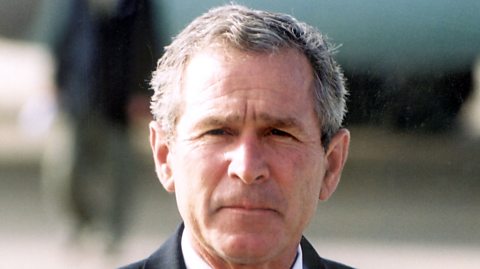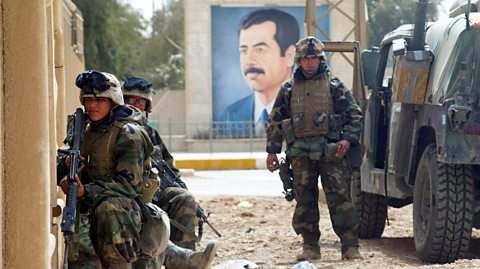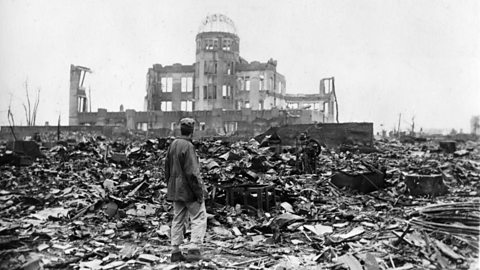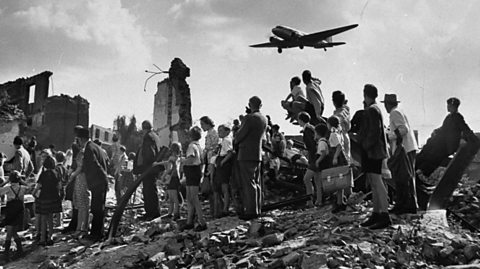Consequences of the Soviet war in Afghanistan

The Soviet War in Afghanistan had far-reaching effects on the USSR and the USA.
Although Mikhail Gorbachev had withdrawn Soviet forces from there in 1989, a dangerous political situation remained.
Millions had died from starvation or from the Soviet bombings and raids.
Among the survivors was a generation of people that had known only war, hatred, and fear.
Several million Afghans had either fled to neighbouring Pakistan for refuge or had become internal refugeeA refugee is a person who has been forced to leave their country in order to escape war, persecution or natural disaster..
The rise of the Taliban and origins of Al-Qaeda
The Soviet invasion of Afghanistan and withdrawal resulted in a weak state full of religious hatred and deep resentment of richer nations.
This would become a breeding ground for terrorism.
In 1994, a group called the Taliban came to prominence.
These were very strict Muslim fighters who imposed strict Sharia law on Afghanistan.
What was Sharia law?
Strict Islamic law that was very harsh, particularly on women.
Osama Bin Laden

The Taliban sheltered some controversial and dangerous figures.
One of them was Osama Bin Laden.
Bin Laden was the leader of the terrorist group Al-Qaeda which he had formed in 1988.
He was from a very wealthy Saudi billionaireвАЩs family but he had become involved as a fighter for theMujahideenA coalition of guerrilla groups in Afghanistan who fought against the invading Soviet forces. in the Afghan war.
Bin Laden recruited Muslims from mosques around the world and developed Al-Qaeda into a militant network, connecting a number of different terror organisations.
He was committed to spreading his religious beliefs across the globe and wiping out western (American) influence.
He used Afghanistan and its remoteness as a place to create training camps and spread his anti-western message.
Bin LadenвАЩs view of the USA
Bin Laden believed Christians and Jews controlled the USA and they were conspiring against Islam.
At the end of the Gulf WarThe United NationsвАЩ operation to liberate Kuwait after it was invaded by Iraq in 1990. in 1991, US troops were still present in Saudi Arabia, a country which contains Mecca, the birthplace of the Prophet Muhammad and the holiest of all cities according to Islam.
This angered Bin Laden who thought the country had been turned into an 'American colonyA group or country controlled by another country.'.
In 1998, Bin Laden issued a іЏ≤є≥ўЈ…ƒеA legal opinion or ruling issued by an Islamic scholar. against the USA which ordered Muslims to kill Americans and their Allies, at any chance they got.
Al Qaeda launched a number of attacks on targets across the world.
They attacked a number of US embassies in Africa before the September 11 attacks in 2001.
It was clear that Al Qaeda was posing a greater and greater risk to American interests.
The attacks of September 11, 2001

On 11 September 2001, the world watched in shock and horror as New YorkвАЩs World Trade Centre Towers were reduced to rubble.
The 'Twin Towers' were widely considered to be symbols of America's power and influence.
The attacks were carried out by nineteen men associated with Al-QaedaAn Islamic terrorist group. who hijacked four airliners which they used to launch suicide attacks on the targets.
The attackers were from Saudi Arabia and several other Arab nations.
Two of the planes were flown into the towers of the World Trade Centre in New York City; a third plane hit the Pentagon just outside Washington, D.C.
A fourth plane crashed in a field in Pennsylvania.
Often referred to as 9/11, the attacks resulted in extensive death and destruction, triggering major U.S. initiatives to combat terrorism.
Over 3,000 people were killed during the attacks, including more than 400 police officers and firefighters.
It was the worst loss of life due to a terrorist incident on U.S. soil.
Reasons for the September 11 attacks
New age of conflict
- After the Afghan war, many MujahideenA coalition of guerrilla groups in Afghanistan who fought against the invading Soviet forces.fighters left to spread jihadStruggle, effort or вАШholy warвАЩ. to other countries
Bin LadenвАЩs hatred of USA
After the Gulf WarThe United NationsвАЩ operation to liberate Kuwait after it was invaded by Iraq in 1990., the USA kept troops stationed in Saudi Arabia. This is where the home of the holiest sites in IslamIslam is the name of the religion, and its followers are known as Muslims. Muslims believe that Islam was revealed over 1,400 years ago, through a man called Prophet Muhammad. (Mecca and Medina) is and many Muslims were upset at the USA permanent military presence there.
Bin Laden issued a іЏ≤є≥ўЈ…ƒеA legal opinion or ruling issued by an Islamic scholar. in 1996 and then again in 1998 which was a declaration of a jihadStruggle, effort or вАШholy warвАЩ. or holy war against the United States.
Bin Laden and others complained about the American military presence in the Middle East, sanctions against Iraq and American support for Israel.
Some historians believe that Bin Laden hoped the attack would encourage the USA to attack the Muslim world - this would increase support for Bin LadenвАЩs cause.
Responses to the 9/11 attacks
How did the USA respond to the September 11 attacks?

The American President George W Bush declared a war on terror, dedicated to hunting down those who had carried out the attack and their supporters.
The American response was also to invade Afghanistan in October 2001 in вАШOperation Enduring FreedomвАЩ.
Question
What does вАШwar on terrorвАЩ mean?
вАШWar on terrorвАЩ was first used by President George W. Bush to explain the military, political, legal and ideologyA set of ideas or thoughts that someone, or a group of people, believe in. The plural of this is 'ideologies'.struggle against organisations which had been labelled as terrorists.
вАШWar on terrorвАЩ also refers to the actions of the USA and its allies against governments that provided these organisations with support or those which posed a threat to the USA and its allies.
How did the rest of the world respond to the September 11 attacks?
The UK and Canada, close allies of the USA, supported its invasion of Afghanistan following the September 11 attacks.
The United Nations (UN)The successor to the League of Nations, the United Nations was established in 1945 as an international organisation designed to keep peace, uphold international law and set standards in human rights. declared the TalibanThe Taliban is an extreme Islamic group, which ruled Afghanistan from 1996 to 2001. They took control again in 2021. and Al-QaedaAn Islamic terrorist group. to be вАШterroristвАЩ organisations and sent a peacekeeping force to Afghanistan in 2002.
The NATONorth Atlantic Treaty Organisation - a military alliance of Western powers originally set up (in April 1949) to provide a counterforce to the Soviet armies of Eastern Europe. joined the war in Afghanistan in 2003.
The 'war on terror' in Afghanistan
Knowing that Al-QaedaAn Islamic terrorist group. and Osama bin Laden were based in Afghanistan, President George W. Bush gave the TalibanThe Taliban is an extreme Islamic group, which ruled Afghanistan from 1996 to 2001. They took control again in 2021. an ultimatum: either hand over Osama bin Laden and his organisation, or the United States would strike with full force.
CongressThe legislative body of the US government, made up of the Senate and the House of Representatives. passed legislation authorising the use of force in striking against terrorist targets.
Operation Enduring Freedom was the official name used by the Bush administration for the war in Afghanistan.
The war in Afghanistan aimed to:
- Find Osama bin Laden.
- Remove the Taliban from power.
- Defeat Al-Qaeda.
- Set up a democracy in Afghanistan which, it was hoped, would help to end Muslim extremism in central Asia.
Key events
On 7th October 2001, attacks were launched on Afghanistan by Western coalition forces along with the anti-Taliban Afghan Northern Alliance.
By November 2001, the Afghan capital of Kabul fell.
By December 2001, air attacks combined with ground forces toppled the TalibanThe Taliban is an extreme Islamic group, which ruled Afghanistan from 1996 to 2001. They took control again in 2021. regime but Osama bin Laden was believed to have escaped.
Within two months, U.S. forces had removed the Taliban from operational power.
However, the war continued, as U.S. and coalition forces attempted to defeat a reorganised Taliban in Afghanistan.
Reasons for the invasion of Afghanistan, 2001
- The TalibanThe Taliban is an extreme Islamic group, which ruled Afghanistan from 1996 to 2001. They took control again in 2021., the ruling power in Afghanistan, were accused by the US of protecting Osama bin Laden.
- There was a lot of international pressure on the Afghan leaders to hand over Osama bin Laden.
- The Taliban refused to hand over Osama bin Laden and as a result, the United States decided they would use their armed forces.
- Taliban requests for negotiations with the U.S. were rejected in favour of military action.
Timeline: Events leading to the invasion of Afghanistan in 2001
Impact on international relations
A new provisional governmentAn interim government or transitional government, is an emergency governmental authority set up to manage a political transition. Afghan government was elected democratically. However, there were many political and tribal divisions which constantly threatened stability. The country also remained severely impoverished by decades of war. Realising that Afghanistan needed more help to create a stable government, the International Security Assistance Force was created in 2003 by the United Nations (UN)The successor to the League of Nations, the United Nations was established in 1945 as an international organisation designed to keep peace, uphold international law and set standards in human rights. to help rebuild Afghanistan.
International relations changed to fight against a new вАШunseenвАЩ enemy. Countries around the world gave their support to the USA and believed that a united front was essential if this new type of enemy was to be destroyed. This coalition of countries promised to help the USA hunt for Osama bin Laden and Al-QaedaAn Islamic terrorist group..
Controversial American methods such as interrogation of prisoners and sending them to tough prison regimes in Guantanamo Bay in Cuba created an international stir and led to many criticising the Americans.
Test your knowledge
More on International relations, 1945-2003
Find out more by working through a topic
- count13 of 13

- count1 of 13

- count3 of 13
